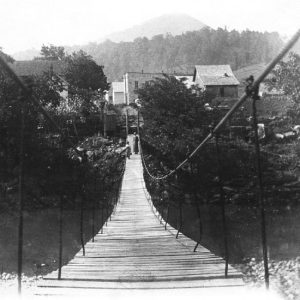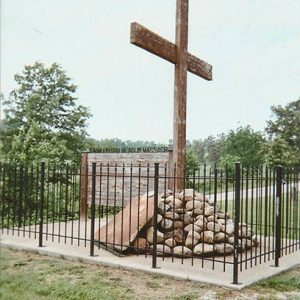calsfoundation@cals.org
Carrollton (Carroll County)
Carrollton (Carroll County), the original seat of Carroll County, was one of the area’s largest settlements in the mid-1800s. The town experienced steady growth before the Civil War but never fully recovered from the war’s devastation, nor from the railroad bypassing it in the 1880s.
The first settlers, James Jones and Henderson Lafferty, arrived in the fertile Long Creek Valley in 1833, the same year the county was created. Jones had obtained title to approximately eighty acres. Shortly afterward, Lafferty, a Methodist minister, purchased land from Jones and established the first store in the county. When a site for the county seat was being sought, Lafferty was able to convince the appointed commissioners to purchase the land near his business. A town site was surveyed by a Dr. Saunders. Being centrally located in the county and on the military road, a town slowly began to grow.
Prior to the construction of the first two-story log courthouse in 1836–37, legal proceedings were conducted about nine miles to the northwest in the home of Charles Sneed. The first session was presided over by future governor Archibald Yell. On July 29, 1834, a post office was established in the growing town. The second county building, a jail, was constructed in 1840, and a new brick courthouse was built in 1844. The town soon was home to four general stores, a blacksmith, two hotels, and several other small businesses. Water was piped into the center of the town from a nearby spring by way of a 200-yard wooden pipe. The town, like the county, was named in honor of Declaration of Independence signer Charles Carroll of Maryland.
In 1836, the Carrollton Methodist Circuit was established, with services being held in the courthouse until a suitable building was constructed. Baptist and Presbyterian congregations were soon established.
Outbreaks of violence with local Native Americans in 1839 resulted in the formation of a militia numbering about thirty members. Within the next ten years, the militia had grown to two battalions that drilled twice yearly. In the mid-1840s, the units assisted in keeping the peace in a political dispute in nearby Marion County known as the Tutt-Everett War.
In 1857, the Fancher wagon train, which was later attacked by Mormons in Utah, passed through the settlement. Some years later, several of the seventeen surviving children of what became known as the Mountain Meadows Massacre came to live in Carrollton.
By 1860, the town was prospering, with some estimating the population at 2,000. According to the census that year, there were eight blacksmiths, two hotels, a tannery, a cobbler, three attorneys, two saddlers, four doctors, three grocers, four merchants, and six mechanics. This prosperity came to a sudden halt with the coming of the Civil War. Due to its size and location, Carrollton became a popular recruiting area for Confederate agents. A home guard organized shortly after Arkansas’s secession was present as part of the Fourth Arkansas Infantry at the 1861 Battle of Wilson’s Creek. Many of the local men enlisted in Confederate regiments that saw action at the battles of Pea Ridge, Prairie Grove, Poison Spring, and other places. Some area men remained loyal to the Union, joining the First and Second Arkansas cavalries.
Carrollton saw considerable activity during the war. In the spring of 1862, a Union army of about 3,000 camped in the area. Shortly after the Battle of Prairie Grove in December, a Union army of some 20,000 under the command of General Francis J. Herron also camped nearby. Such large numbers of soldiers created problems for the town. Skirmishes were fought in the area in 1863 and 1864. Once the armies moved out, the area was ruled by guerrillas and bushwhackers. The community suffered considerable damage from such forces, and, by the end of the war, all of the town’s buildings, excluding two stables, had been burned.
The town slowly began to recover, though the new courthouse begun in 1866 was destroyed by fire. The county government was moved into a reconditioned building where it remained until the county seat was removed in 1875. Approximately three years later, however, the town’s future became more uncertain. In 1869, large portions of land were separated from Marion and Carroll counties to create Boone County. This left Carrollton, once centrally located in the county, just three miles from the Boone County line. An immediate push was made by citizens to relocate the county seat to Berryville (Carroll County). After several elections and lawsuits, by a majority vote of twenty-eight, the decision to move the county seat was made on June 17, 1875.
A newspaper, the Carroll County Bowlder, was founded by W. S. Tipton in November 1875. Perhaps to promote growth, the town was incorporated on March 23, 1876. Still, just five years later, the population had dropped to 113. However, the Cincinnati Mills, which could process 100 bushels of wheat and 250 bushels of corn a day, opened in 1883. Sometime in the 1880s, a school was constructed; at its peak, as many as 200 students attended. By 1890, the population of the town had grown to 250. However, permanent decline came just after the turn of the century when the railroad bypassed the town three miles to the east through Alpena Pass, where a depot was built. The Carrollton post office was closed, and even some of the town’s buildings were moved to the tracks. The town rapidly declined until little remained but farm families.
Today, all that remains of the once prosperous town is a cemetery and the Yell Masonic Lodge Hall, which was built in 1876. The lodge was added to the National Register of Historic Places in 1984.
For additional information:
Croley, Victor A. “Old Carrollton—It Holds a Host of Arkansas History.” Arkansas Gazette. October 8, 1967, p. 5E.
The History and Families of Carroll County, Arkansas. Paducah, KY: Turner Publishing Company, 2003.
Kennedy, Steele T. “New Park in an Old Town.” Arkansas Democrat. April 12, 1959, pp. 3–4.
Mike Polston
Encyclopedia of Arkansas History & Culture
 Carroll County Map
Carroll County Map  Carrollton Swinging Bridge
Carrollton Swinging Bridge  Mountain Meadows Massacre Monument
Mountain Meadows Massacre Monument 




Comments
No comments on this entry yet.